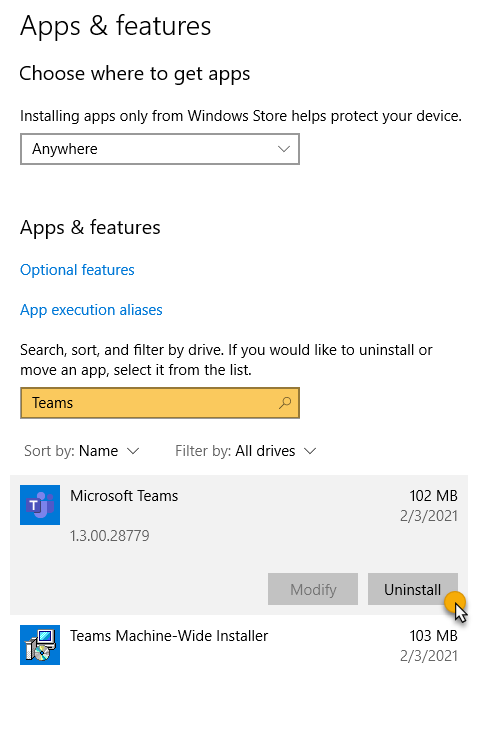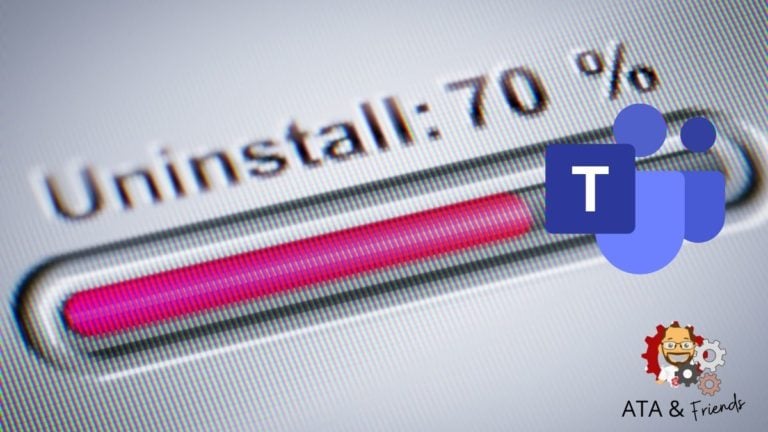If you no longer need Teams installed on your computer, you can uninstall Microsoft Teams. Sounds easy, right? It’s not that simple, unfortunately.
Microsoft Teams comes with multiple items to uninstall and requires specific actions to ensure it doesn’t come back. Seeing Microsoft Teams make a return can be frustrating to experience!
In this article, you will learn how to uninstall Microsoft Teams on a Windows 10 device. You will also learn strategies to prevent Microsoft Teams from installing in the first place or even reinstalling! Finally, you’ll see an alternative to uninstalling that might help solve your problem for good!
Prerequisites
If you plan on following along step-by-step during the uninstall process, you will need the following:
- A Windows 10 computer – This tutorial will be using Windows 10 Build 18363
- Local administrative rights on the Windows 10 computer to remove software. If you are unsure if you have local administrator rights, check out this Microsoft Office support article.
- An existing installation of Microsoft Teams. Per-user installs can be found at https://aka.ms/getteams, and MSI-based installers are located in Microsoft’s documentation.
Understanding How Microsoft Teams Gets Installed
You can install Microsoft Teams in two different ways: on a per-user basis and a per-machine basis. The per-user method allows for end-users to install it themselves without requiring local admin rights. Per-machine is for IT departments to deploy to all users on a system.
Per-User
Windows 10 users can install Microsoft Teams themselves by navigating to https://aka.ms/getteams. Windows users do not require local administrator rights as it installs into the user’s AppData folder. If a user installs the app for themselves, it’s not available for other users on the same computer.
Per-Machine
For a more automated experience, administrators can install Microsoft Teams using an MSI package found here. Administrators use MSI packages to install Microsoft Teams to multiple systems.
When you install using the Microsoft Teams MSI package, the MSI places an installer inside the Program Files folder. Depending on the system architecture, the machine-wide installs are in one of two places:
- For 64-bit Windows 10, the Teams.exe machine-wide installer is located in C:\Program files (x86)\Teams Installer.
- For 32-bit Windows 10, the Teams.exe machine wide-installer is located in C:\Program Files\Teams Installer.
When a new user signs into the Windows 10 system, the installer places a copy of the Microsoft Teams app into that user’s AppData folder. If the user already has a Microsoft Teams app installed in this folder, the MSI installer skips the process.
After the user has Microsoft Teams installed in their profile, the per-user app will automatically upgrade to the latest version. The MSI installer installs the Microsoft Teams app for each new user logging into the Windows 10 system.
Uninstalling Microsoft Teams from Windows 10
Regardless if you have Teams installed on a per-user or per-machine basis, you can still uninstall a program like Teams. The process to do so is nearly identical. To do so:
- Open up Apps and Features in the Settings app by right-clicking the Start menu and choosing Apps and Features. If you have many apps installed, use the search box to find all instances to ensure they are removed.

2. In the Apps & features windows, search for “Teams” in the search box to find the Microsoft Teams app instances. If you installed Teams with the per-user app installer, you’d only see Microsoft Teams. If you installed Teams using the MSI, you’d also see Teams Machine-Wide Installer.
3. Select the Microsoft Teams item, then select Uninstall to remove the per-user app installation. If needed, select Teams Machine-Wide Installer to also remove the MSI package. You can see how to do this below.

That’s it! That’s all there is to uninstalling Teams. Sounds simple enough, right? Not exactly.
Clearing the Microsoft Teams App Cache
When you install Microsoft Teams, it creates a cache not tied to the installation itself. It caches information like icons, policy settings, and message history on the local system. This cache can be left behind when uninstalling Microsoft Teams.
Teams can cache information in two folders:
- All Users Location – %AppData%\Microsoft\Teams
- Per-User Location – AppData\Roaming\Microsoft\Teams under each user profile
You must delete these folders to ensure you have fully removed Microsoft Teams. You can do so in any way you’d like but below we’ve provided a PowerShell script to help.
The below script:
- Uses the
">Get-ChildItemcommand retrieves all the folders in both the all users Teams directory and each user. - Filters the list of folders found with the
">Where-Objectcmdlet only returning expected folder names - For each of the matching directories, the
Remove-Itemcommand deletes the folder and any subfolders.
## Remove the all users' cache. This reads all user subdirectories in each user folder matching
## all folder names in the cache and removes them all
Get-ChildItem -Path "C:\Users\*\AppData\Roaming\Microsoft\Teams\*" -Directory | `
Where-Object Name -in ('application cache','blob_storage','databases','GPUcache','IndexedDB','Local Storage','tmp') | `
ForEach {Remove-Item $_.FullName -Recurse -Force}
## Remove every user's cache. This reads all subdirectories in the $env:APPDATA\Microsoft\Teams folder matching
## all folder names in the cache and removes them all
Get-ChildItem -Path "$env:APPDATA\Microsoft\Teams\*" -Directory | `
Where-Object Name -in ('application cache','blob storage','databases','GPUcache','IndexedDB','Local Storage','tmp') | `
ForEach {Remove-Item $_.FullName -Recurse -Force}
Related: How to Use PowerShell Where-Object to Filter All the Things
Related: Use PowerShell to Delete a User Profile (Step-by-Step)
Customizing a New Office Deployment to Remove Teams
Beginning in July 2019, Microsoft added Microsoft Teams to existing installs of Microsoft 365 Apps. The installation occurs as part of the regular update process starting in Version 1906.
If you have to manage many Office installations, Microsoft provides a tool to help called the Office Deployment Tool (ODT). The ODT is a handy tool that downloads and deploys Microsoft 365 apps to your organization’s computers.
ODT gives administrators more control over an Office installation, such as defining which products and languages are installed, how the products are updates, and if the install is visible to the user.
To set up an Office deployment with ODT that removes Teams:
- Download the Microsoft Office Deployment Tool.
2. Extract the ZIP file. This file will contain two files; setup.exe and configuration.xml. This tutorial will assume the folder is located at C:\ODT.
3. Add Microsoft Teams as an excluded app in the XML configuration file. Below is an example configuration file that:
- Installs the 64-bit version Office (
OfficeClientEdition="64") - Configures updates on the Current channel (
Channel="Current") - Excludes Microsoft Teams (
<ExcludeApp ID="Teams"/>)
<Configuration>
<Add OfficeClientEdition="64" Channel="Current">
<Product ID="O365ProPlusRetail">
<Language ID="MatchOS" />
<ExcludeApp ID="Teams" />
</Product>
</Add>
<Display Level="None" />
</Configuration>
4. Open up a Windows command prompt or PowerShell and navigate to C:\ODT.
5. Invoke the ODT’s provided setup.exe installer with the /configure switch providing the path of the example configuration XML file.
setup.exe /configure configuration.xmlCustomizing an Existing Office Deployment to Remove Teams
To exclude Microsoft Teams from an existing Office install, use the following configuration file. This configuration file differs from the one above in that it is matching the version (Add Version="MatchInstalled") and language (Language ID="MatchInstalled") of the existing Microsoft 365 apps installation.
<Configuration>
<Add Version="MatchInstalled">
<Product ID="O365ProPlusRetail">
<Language ID="MatchInstalled" TargetProduct="All" />
<ExcludeApp ID="Teams" />
</Product>
</Add>
<Display Level="None" />
</Configuration>
Ensuring Teams is Gone for Good
When you uninstall Microsoft Teams, it might not be gone for good. To ensure Teams stays gone, you’ll need to use Group Policy or set a registry key to prevent it from being installed again by other processes. For example, one popular way Teams can get installed again is during an Online Repair of the Microsoft 365 Apps suite.
Using a Registry Key to Prevent Microsoft Teams Installations
If your computer or set of computers you’d like to keep Teams from installing on is in a workgroup, or you use some other tool to deploy changes to workstations, set a registry value.
If performing the registry value change manually on a computer:
- Open up the Windows Registry Editor.
- Navigate to HKEY_LOCAL_MACHINE\SOFTWARE\Policies\Microsoft\Office\16.0\common\officeupdate
- Create a new REG_DWORD value named preventteamsinstall.
- Set this value to 1 to prevent Microsoft Teams from installing again.

Using Group Policy to Manage Microsoft Teams Installations
If you’re managing many Windows computers in an Active Directory domain, chances are you’re not going to want to hit up each computer and use the Registry Editor manually. You’ve got better options, one of them being Group Policy.
Luckily, Microsoft provides Microsoft 365 Administrative Templates with options to prevent Microsoft Teams from installing.
You will need v4882.1000 released on July 9, 2019 of the Microsoft 365 administrative templates. The policy you need applies only to Version 1905 or later of Microsoft 365 Apps (formerly Office 365 apps).
To create a GPO to ensure Microsoft Teams stays uninstalled:
- Set up the Microsoft 365 administrative templates on your domain controllers.
2. Create a new Group Policy Object (GPO) calling it Disable Microsoft Teams Installation or something similar.
3. Inside of the GPO, navigate to Computer Configuration —> Policies —> Administrative Templates —> Microsoft Office 2016 (Machine) —> Updates.
4. Double-click on the Setting Don’t install Microsoft Teams with new installations or updates of Office and enable it.
If you enable this policy, Microsoft Teams will not be installed in the following scenarios:
- New installs of Microsoft 365 Apps
- Updates to existing installs of Microsoft 365 apps
- User self-installs from the Office 365 portal
- Online Repair installs of existing Microsoft 365 Apps

Assign the GPO to the domain or OU of computers you’d like to apply it to.
Next Steps
While uninstalling Microsoft Teams takes a few clicks, ensuring it does not come back or get installed in the first place takes extra steps. Administrators and desktop support personnel need to understand the different parts and scenarios to stay on top of their Microsoft Teams client deployments.
For your next challenge, see if you can find a way to remotely remove the software or clear the cache without visiting the user’s system!
Check out more Microsoft Teams articles over at https://jeffbrown.tech.




